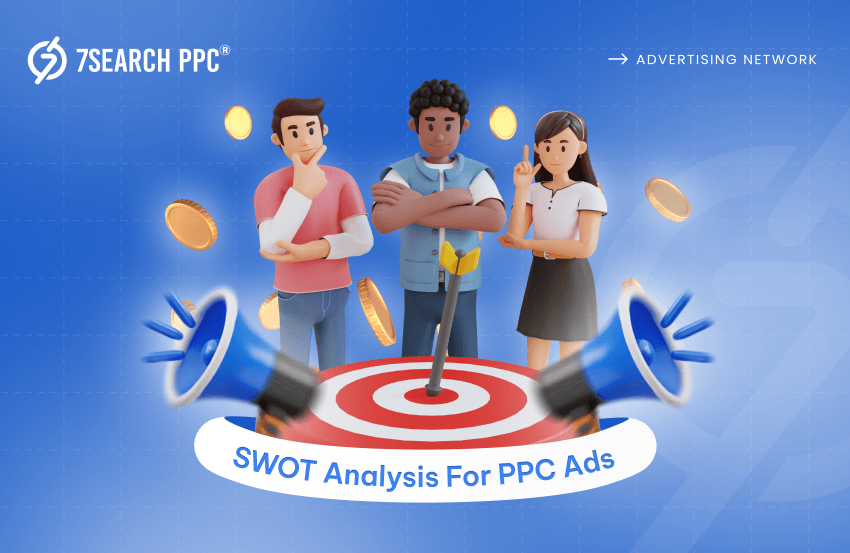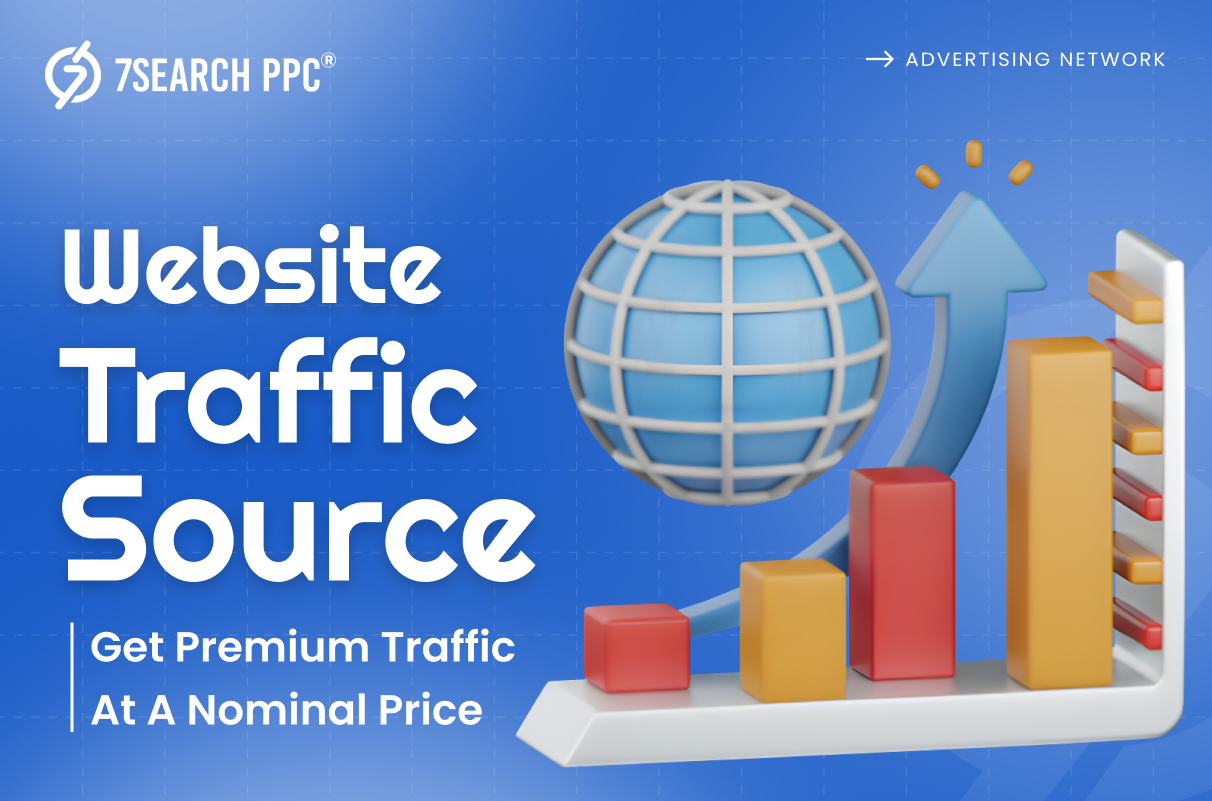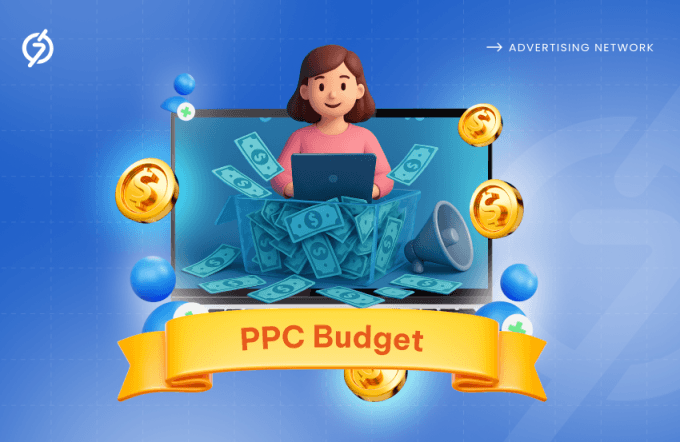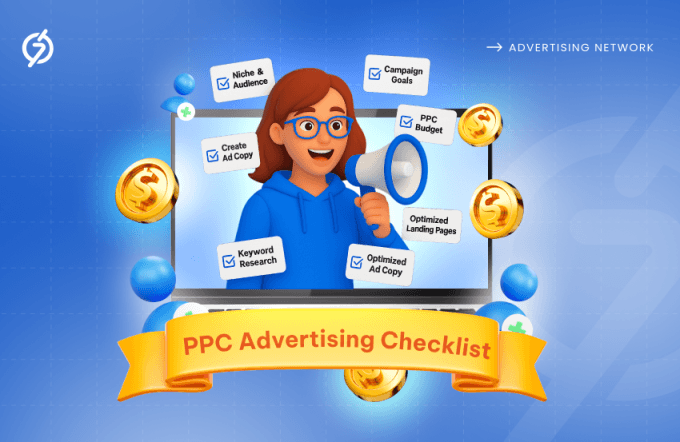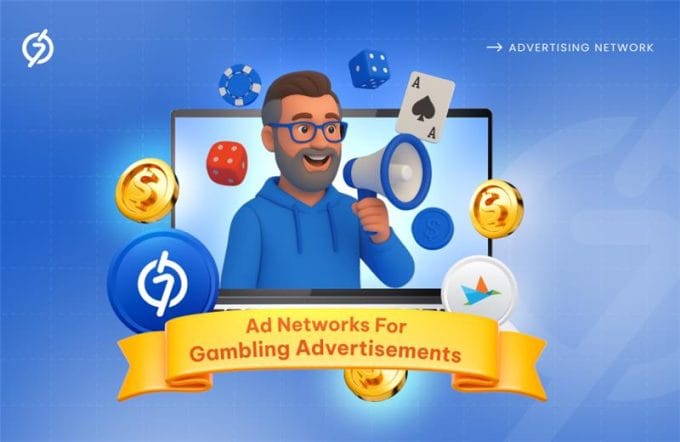Every time you search for something on Google, the first result will typically be an ad. When you open a website, you will see one or more ads. No matter where you go on the interwebs, you can find these ads. These are the ads that, in technical terms, are called PPC or Pay Per Click ads.
The rationale behind PPC ads is only when a person clicks on one of these does the advertiser have to pay the publisher. It is excellent from a business point of view because they don’t have to pay to display their ads instead, it only costs them money when someone interacts with their ads.
Due to cost advantages and effectiveness, PPC marketing has become one of the quickest and most efficient ways of driving customers to a particular website. However, it can be challenging to make money from PPC ads.
It is too easy to make a minor mistake that can destroy your campaign, which is why having a cohesive PPC strategy is essential for any business indulging in this practice.
A prominent strategy that business analysts use can also help you with preparing a robust PPC ad campaign. A SWOT analysis can help you look at different PPC ad campaigns’ different sides and improve their performance.
With the correct implementation of SWOT analysis, you can take your PPC campaigns to new heights.
What Is SWOT Analysis?
In technical terms, a SWOT analysis is a corporate evaluation technique that business analysts use to assess something’s viability, from an entire company to a single PPC campaign.
SWOT in SWOT analysis is an acronym that stands for Strengths, Weaknesses, Opportunities, and Threats.
Strengths and weaknesses are the factors that an individual or organization can control, whereas opportunities and threats are external factors that a business cannot influence.
Adapting to external factors is more crucial for a business because whether you like it or not, you cannot change what’s happening in the market; you can only react to it.
SWOT analysis is a tool that experts use to analyze the operational level to assess a company’s position in marketing and identify the areas for improvement and future growth.
You can also apply the same SWOT analysis principles to your PPC campaigns to figure out how well your campaigns perform, what’s holding you back, and what you can do differently to improve your situation.
Why Is It Essential To Do A SWOT Analysis For PPC Campaigns?
A properly conducted SWOT analysis can save your underperforming PPC campaigns from failing.
The biggest mistake brands often make is that they analyze their PPC campaigns in isolation. They account for their keywords, bids, and landing pages.
While these factors are essential for a PPC campaign’s success, you should also not forget that your PPC campaign does not exist in a vacuum.
Every business is competing with hundreds of other brands for the top spots, so understanding what your competitors are up to is the key to success.
A SWOT analysis will help you figure out the external factors that can influence your PPC campaigns. Competitors, the economy, and your industry’s state are all things that can alter your ads’ performance and impact the likelihood of someone purchasing after clicking on your ad.
You can also identify new opportunities for your PPC ad campaign. SWOT analysis will help you understand whether to double down on what you are doing well, or whether it’s time to fix your weaknesses.
When you look at everything – what’s working and what’s not, it becomes much easier to develop a strategy that involves a comprehensive plan to fix the issues rather than just raising your bids.
The ultimate aim of implementing SWOT analysis to your PPC ad campaign is to look at your ad campaigns differently. Despite the enormous amount of advice, you can find on optimizing your PPC campaigns, it is understandable to get stuck in a routine of keyword research, testing new ad copy, and creating new landing pages.
When you look at your PPC ad campaign from a different perspective, you can find how much more you can improve your ad’s performance. SWOT analysis is just a tool that allows you to see your PPC ad campaign in a different light and help you take your PPC campaigns to a new height.
How To Do SWOT Analysis Of Your PPC Ad Campaign?
First, you need to sit down with your team and figure out each campaign’s strengths, weaknesses, opportunities, and threats. Write all these down by creating a 2×2 grid on paper, or you can make a table with four columns each for one letter of “SWOT.”
There can be multiple reasons why one wants to conduct a SWOT analysis of their PPC campaigns. You might want to figure out why your PPC ad campaigns are not driving as much sales as your Facebook and YouTube ads.
A business might want to use SWOT analysis techniques to optimize a well-profitable channel.
Before starting a SWOT analysis, you need to set a final goal you are trying to reach. Without a clear objective, you cannot implement any insights you gain from conducting a SWOT analysis. When focusing on your PPC campaign, you have to narrow your focus to get a clear picture of what you are trying to achieve.
It would help if you did a SWOT analysis with your entire marketing team; this way, they can contribute their views and opinions.
The more views and opinions you can get, the more apparent the picture will become. You can choose to brainstorm together, or you can do the analysis individually, and then on completion, you can discuss your findings.
When brainstorming, try to keep things as even as possible. For instance, if you have ten strengths, try to find ten weaknesses. Look for a threat for every opportunity you have, and you will start to see clearly.
It is best to start the SWOT analysis in the order of its letters.
S – Strengths
The initial step in the SWOT analysis is to know what you have, which means listing all the strengths, which can help you create an excellent PPC ad campaign.
Strengths are the internal factors that are favorable to your PPC campaign efforts. For example, having a high-quality score, an excellent ROI, a high CTR, a low bounce rate, and covering relevant keywords can be the strengths of your PPC campaign.
You can also include the advantages you hold over your competitors in this list too. These can consist of your PPC agency partner, the quality of your products, and your brand recognition. Remember that your strengths can extend beyond the things specific to your PPC ad campaign.
You have to consider all the strengths to get a fair picture of what you are trying to assess.
W – Weaknesses
The next step is to look for the things that can counter your strengths. These weaknesses are of the sort that you can control. The trivial things often contribute to a decrease in your ROI; these can include your campaign’s lack of A/B testing.
Your PPC ad campaign can also suffer from some broader weaknesses, including a small budget or a lack of PPC experts.
Ensure only to include the things in this category that are under your control. For instance, a well-established and well-funded competitor is not a weakness to your PPC ad campaign because you don’t have control over your competitors. However, you can choose a different strategy or stop competing.
When you are in a difficult position, look at the strengths section to find something you can use to negate your weaknesses.
O – Opportunities
After you get a good idea about the internal factors, i.e., your strengths and weaknesses, it’s time to focus on the external factors that can influence your PPC ad campaigns.
Opportunities are favorable factors that can help improve your PPC ad campaigns in the future. An expected increase in your product’s demand due to seasonal activities is an example of an opportunity in which you can capitalize.
Similar opportunities might also arise if a competitor is on the verge of collapse or changing its business model.
When looking at the opportunities, try taking into consideration their time frame. A seasonal increase in demand may last for a month or two. However, the ongoing market growth can last for years.
These opportunities can be great for turning your weaknesses into strengths.
T – Threats
The final step is to look at the threats to your PPC campaign. A business does not have any control over these external factors, and this is the category where you can put your well-established and well-funded competitors.
The threats are not limited to the competition. It would help if you considered other things, such as how the market is reacting to your current products, how people are changing their preferred shopping locations.
Other threats can include changes in the status quo that might impact your success, for instance, your employee taking a new job.
It can also help if you approach it from a broader level by looking at the whole industry. You have to find out where your market is stable, or a slight change in the market can weaken your products’ demand.
How To Make Your SWOT Analysis Actionable?
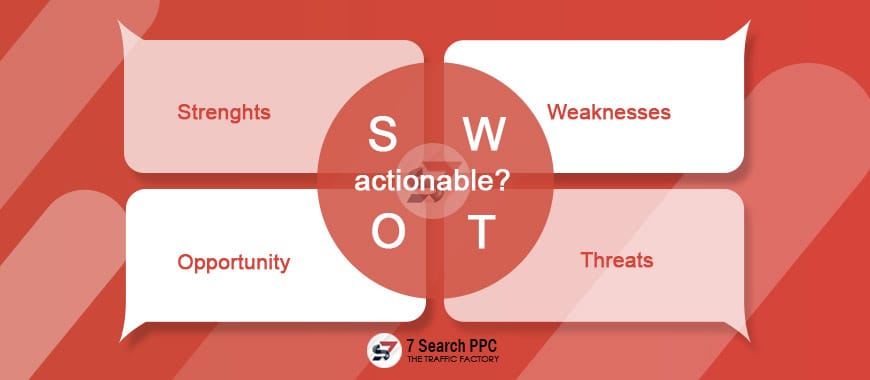
While SWOT analysis is excellent for understanding where your PPC ad campaigns currently stand, it will not produce any actionable results. The person doing the SWOT analysis needs to make it actionable.
You can begin by looking at the relationships between each section. Figure out whether it is possible to use your strengths to create new opportunities or if you can counter threats by working on your weaknesses.
The first thing you can do is find ways to turn your strengths into new opportunities. It means that you can do more of what you are good at to improve your PPC campaign’s health.
For example, if you are good at creating landing pages, you can make more landing pages for your ad groups. That will improve your quality score and decrease the bounce rate, resulting in increased conversion rates.
The next step is to identify how you can turn your weaknesses into strengths. For instance, if you lack a PPC expert, you can quickly fix that issue by hiring one, assuming, of course, you have a budget for that, or you can work with a digital marketing consultant.
Next, you can look at the available opportunities and find a way to capitalize on them. Maybe e-commerce growth can provide you with an excellent chance of growing your business.
One approach can be to increase the PPC budget to show ads to more people and take advantage of e-commerce growth. Alternatively, you can also create new ads and landing pages for new products.
The final thing to look at is threats. You cannot change these directly. However, you can take steps to mitigate their impact on your PPC ad campaigns. For instance, if you are competing against someone with a big budget, you can maximize your ROI as much as possible by targeting longer-tail keywords.
Takeaway
Doing a SWOT analysis can be an excellent way to get a new perspective on your PPC ad campaign. Don’t forget that your PPC campaigns don’t exist in isolation, so your optimization efforts should consider that.
If you think of your ad campaigns in a broader market and economic context, you can optimize your PPC campaigns at the level that your competitors cannot even think to reach.
Try not to stop creating new ad copies and running A/B tests; find ways to capitalize on new opportunities arising in the market.

